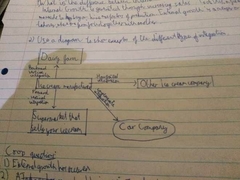![]()
![]()
![]()
Use LEFT and RIGHT arrow keys to navigate between flashcards;
Use UP and DOWN arrow keys to flip the card;
H to show hint;
A reads text to speech;
13 Cards in this Set
- Front
- Back
|
What are the characteristics of a competitive market? |
1) many firms in the market 2) good sold by the competing firms must be close substitutes for each other. 3) no barriers to entry into the market. 4) firms have all the information they need (e.g. competitor prices). 5) firms are price-takers. |
|
|
What are the advantages of a competitive market? |
1) Responds quickly to consumer demands, with lower prices and higher quality goods and services. 2) Produces a wide variety of goods and services to meet consumer wants. 3) encourages efficiency. |
|
|
What are the disadvantages of a competitive market? |
1) the factors of production will only be employed if it is profitable to do so. 2) The market fails to provide certain goods and services (e.g. NHS). 3) Maybe courage consumption of demerit goods. 4) social effects of production ignored (e.g. obesity, pollution). 5) system allocated more goods and services to those that can afford them, causing increased inequality. |
|
|
What are the characteristics of monopolies? |
1) There is only one firm in the market (for a pure monopoly). 2) There are high barriers to entry. 3) There are no close substitutes. 4) Firm can set its own price. |
|
|
In the UK, what is the definition of a legal monopoly? |
A market in which any firm has a market share above 25%. |
|
|
What are the consequences of a monopoly? |
1) Diminish consumer choice. 2) Reduces incentive to innovate 3) Raise prices to inequitable levels. |
|
|
What is an oligopoly? |
A state of limited competition, in which the market is shared by only a small number of buyers and sellers. |
|
|
What is the difference between a firm growing internally and growing externally? |
Internal growth is generated through increasing sales. To do this, a firm needs to buy or hire more factors of production. External growth is a merger or takeover, where one firm joins with another. |
|
|
What are the different types of integration? |

1) Vertical integration (forward and backward): integration along a firm's supply chain. 2) horizontal integration: taking over a competitor 3) Conglomerate integration: taking over a firm in a separate industry. |
|
|
What is the difference between a merger and a takeover? |
When two companies join together, it is a merger if the joining is voluntary, or a takeover/acquisition if it is forced or hostile (accomplished by purchasing the target firm's shares, without consent). |
|
|
Give some reasons for firms to join together. |
1) To benefit from economies of scale. 2) To reduce competition. 3) To increase market share. 4) To gain access to new ideas/products (diversification). 5) To reduce costs. |
|
|
Give some potential disadvantages of a merger. |
1) Diseconomies of scale. 2) Reduced choice for consumers 3) Higher prices 4) Financial costs of takeover 5) Problems arising because firms' owner and managers may have conflicting aims. 6) Increased unemployment. |
|
|
When does the government intervene to stop a merger? |
The Competition and Markets authority will take an interest if either: 1) the business being taken over ha a UK annual revenue of at least £70 million. 2) The combined businesses would have at least a 25% share if ant reasonable market. They would consider: 1) Market share 2) Whether there are credible competitors 3) Whether the business ha control of its own distribution network 4) Whether it will have favourable access to raw materials. |

